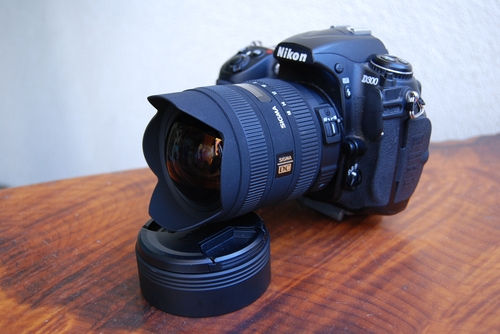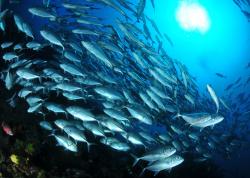Specs and design
Sigma 8-16mm Specs, Design, Focus and Operation
Specs & Design
The Sigma 8-16mm lens is the widest available rectilinear lens for cropped sensor dSLR cameras. The lens is quite complex, with 15 elements in 11 groups. The lens contains Sigma’s new FLD glass elements, which have the performance equal to fluorite glass, and compensate for color aberration. In addition to having four elements of the FLD glass, the 8-16mm lens also offers one hybrid aspherical lens and two glass mold elements for correction of distortion and astigmatism.
There is no image stabilization, but the nice thing about wide-angle lenses is that they are easier to shoot hand-held at slow shutter speeds if you need to.
Filters and front element
The front of this lens is not flat, but bulbous, similar to the Nikon 14-24mm, 10.5mm fisheye, or Tokina 10-17mm fisheye. There's not much to protect the glass other than a small petal-type hood.
Because of this, the lens does not take a filter. Of course, graduated neutral density filters large enough can be held in front of the lens. Sigma does include a cover with a 72mm cap, but even at 16mm you can see the cap in the photo, so I don't recommend taking photos with the cap on.
Here's the Sigma 8-16mm lens, showing the exposed front element and the petal-style hood. The fist ring is for manual focus, and the second ring closer to the camera body is for zooming in and out. The lens is resting on the large cover & cap that can be placed over the hood of the lens.
Official specs from Sigma:
Lens Construction: 15 Elements in 11 Groups
Angle of View: 114.5-75.4 (this is on a Canon camera, Nikon AOV is larger)
Number of Diaphragm Blades: 7
Miminum Aperture: f22
Minimum Focusing Distance: 24 cm / 9.4 in
Maximum Magnification: 1:7.8
Dimensions: (Diameter x Length) 75x105.7 mm/3.0x4.2 in
Weight: 555g / 19.6oz.
Mounts: Nikon, Canon, Sigma, Sony/Minolta, Pentax
Build Quality
Build quality on this lens is great. It feels solid and well made. The lens has a metal mount. There is no zoom creep. Zooming does not change the length of the lens at all.
Holding the lens and zooming feels very comfortable. The only control on the lens is the switch between auto-focus and manual focusing.
Auto-focus
The lens has a built-in silent auto-focus motor, which Sigma calls HSM. Focuses is fast, silent and easy, although it usually is quick for lenses this wide, even without an internal auto-focus motor.
Close focus & macro capability
The lens can focus on an area 12.25 inches wide at 8mm, and 7 inches wide at 16mm. The close-focus distance does not change at different focal lengths. At the closest focus distance, the subject is about 3 inches from the glass. Getting the closest possible focus distance was a little easier when I used the spot-focus mode, instead of multiple focus points.
Aperture range
- 8mm: F4.5 - F22
- 16mm: F5.6 - F29
Continue to wide-angle lens comparison

RECOMMENDED ARTICLES
SUPPORT THE UNDERWATER PHOTOGRAPHY GUIDE:
The Best Service & Prices on u/w Photo Gear
 Visit Bluewater Photo & Video for all your underwater photography and video gear. Click, or call the team at (310) 633-5052 for expert advice!
Visit Bluewater Photo & Video for all your underwater photography and video gear. Click, or call the team at (310) 633-5052 for expert advice!
The Best Pricing, Service & Expert Advice to Book your Dive Trips
 Bluewater Travel is your full-service scuba travel agency. Let our expert advisers plan and book your next dive vacation. Run by divers, for divers.
Bluewater Travel is your full-service scuba travel agency. Let our expert advisers plan and book your next dive vacation. Run by divers, for divers.































